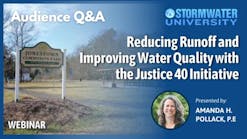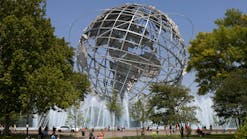New Park Pioneers a Model for Green Spaces Through Sustainable Designs
About the author:
Wendy Chan is a senior landscape architect at MIG and can be reached at [email protected].
The award-winning Earvin “Magic” Johnson Park is a 126-acre park located in the community of Willowbrook in South Los Angeles – the largest open space in the area. The renovation of this park began in 2014 when the multi-disciplinary design and planning firm MIG, developed the conceptual comprehensive plan to show what a complete makeover could look like, including new recreation amenities and innovative water sustainability approaches. With Phase 1A and 1B of the Magic Johnson Park Revitalization Project complete, the park is hailed as the gold star in sustainable park design.
The $83 million Phase 1A, which opened in January 2021, demonstrated the latest technology in storm water treatment systems. The project diverts and captures storm water runoff from the community’s 375-acre watershed, which is part of the overall Compton Creek Watershed. The storm water is then treated through a system of processes including natural biofiltration through mitigated wetlands surrounding one of the park’s two lakes. The treated water is stored within both lakes and reused for on-site park irrigation. The freshwater marsh wetland also creates an important habitat for resident and migratory birds, insects and other urban wildlife. This technology, coupled with the existing lakes, allows for the capture, storage, treatment and recycling of water and acts as a catalyst for urban greening and meaningful outdoor space throughout Southern California.
Before the renovation, the park used 100% potable water for landscape irrigation and for filling the two existing man-made lakes. To minimize potable water use, the park was re-engineered through collaboration with the Los Angeles County Development Authority, Los Angeles County Department of Parks and Recreation, and Los Angeles County Public Works to provide a sustainable new water source using a unique storm water management system to recycle the runoff from the watershed. This system captures urban and storm water runoff (dry and wet weather flows), treats the captured flows, then fills the existing lakes, while improving water quality in Compton Creek, Los Angeles River and Pacific Ocean.
How the Storm Water System Works
So, how does it work? Wet weather first-flush flowing from the Compton Creek Watershed is first captured through a runoff diversion structure, which was constructed to tap into an existing Los Angeles County Public Works maintained 84-inch diameter storm drain. This storm drain diverts flows of up to 33 cubic feet per second (cfs) to a new pump station that sends flows to a new treatment facility at the park. The water is then treated and discharged to constructed mitigated wetlands surrounding one of the park’s two lakes. Treated storm water fills both lakes totaling 15 acres and is then used to irrigate the park. It is estimated that the park’s irrigation demand can be met by the storm drain diversion flows for a significant portion of the year, amounting to approximately 7-acre feet (2.3 million gallons) of flows from a significant wet weather event.
A pump recirculates the water from the north lake (lower elevation), through the treatment plant at approximately 2,500 gpm, to the south lake (higher elevation), to the stream, and back to the north lake. This provides a horizontal circulation system to prevent stagnation in both lakes. This also helps to maintain water quality and provides flow for the aesthetic stream between the two lakes. The treatment facility also includes potable irrigation and splash pad wet wells, irrigation and splash pad pump skids, filters, oxygen generator and chemicals storage rooms.
This storm water management system also improves water quality by removing heavy pollutants, such as bacteria, oil, excess nutrients, metals, and trash that would have otherwise made its way to the Pacific Ocean through Compton Creek and the Los Angeles River. Runoff flows are treated with Aluminum Sulfate (alum) for coagulation and sedimentation with an inline static mixer, dye to reduce photosynthesis, and ozone to disinfect pathogens while also reducing color and turbidity.
RELATED: San Antonio River Authority Develops Green Storm Water Infrastructure Plan
The Workings of the Wetlands
The submerged wetland planting areas along the lake edge further enhance the lake water quality through naturally occurring physical and biological processes. Treated water from the treatment plant is discharged to boxes throughout the perimeter of the lake into the wetland planting areas. Sediment particles are then separated from the water by gravitational settling. This process removes suspended solids, particulate nitrogen, oils, chlorinated hydrocarbons, and most heavy metals from the water column. The velocity of the water discharged at each box is small, allowing for sedimentation while the treated water flows through the wetland plants in the lake. The sediment can be removed from these boxes through routine scheduled maintenance and does not accumulate at the lake bottom. After the treated water enters the lake, it is circulated back to the treatment pump station where additional treatment occurs.
Earvin “Magic” Johnson Park not only benefits the environment by providing improved storm water quality for the existing lakes but also serves as a storm water treatment and landscape infrastructure system that benefits both the natural and socio-ecological environment.
Through this project, restoration of some Southern California's vital native plant communities, such as the Coastal Sage Scrub and Freshwater Marsh Wetland Habitats have been achieved. The constructed wetland and the restored lakes on this project provide important habitats for resident and migratory birds, pollinators, fish, and other urban wildlife by providing food, shelter, and places to nest. Some of the species that now frequent and nest at the park are grey heron, black-crowned night heron, red-tailed hawk, and black-necked slits.
It was also important to integrate and showcase the storm water treatment center as both a community amenity and a facility that will educate future generations on water conservation. Other amenities of the park include:
- 20,000 square foot Community Event Center
- A ½ mile lakeside community loop trail with picnic areas
- Fitness equipment
- Scenic viewing points
- A destination children’s play area with splash pad
- Outdoor classrooms and educational interpretive graphics telling the environmental story of the park
- Community social spaces
- Wedding lawn
- ¾ mile of walking trails
- The first off-leash dog park in South Los Angeles
- Educational California native habitat gardens
- An informal natural amphitheater
- A community flexible lawn space
The Importance of an Interactive Space
The inspiration behind the project was to transform a widely used community-based park into something much more: an interactive and dynamic center of learning, nature and engagement that is powered through environmentally sustainable design. It is intended to be a hub for the community to gather, recreate, celebrate and learn.
As the prime design consultant through Los Angeles County Development Authority, and Los Angeles County Parks and Recreation, MIG collaborated with over 20 sub-consultants on the project including Pacific Advanced Civil Engineering Inc. (PACE), which designed the environmentally sustainable treated storm water treatment system.
The project closed out 2021 with six awards under its belt including Sustainable Engineering Project of the Year from the American Society of Civil Engineers, Award of Excellence from the American Society of Landscape Architects - Southern California Chapter and Project of the Year from the United States Green Building Council - Los Angeles.






